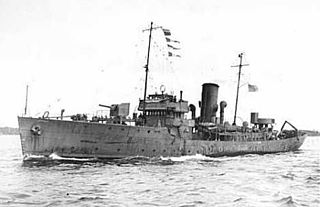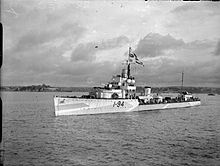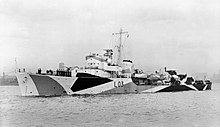
The Flower-class corvette was a British class of 294 corvettes used during World War II by the Allied navies particularly as anti-submarine convoy escorts in the Battle of the Atlantic. Royal Navy ships of this class were named after flowers.

HMCS Snowberry was a Flower-class corvette that was originally built for the Royal Navy, but spent most of the war in service with the Royal Canadian Navy. She fought primarily as a convoy escort during the Second World War. She served primarily in the Battle of the Atlantic.
Escort Group B2 was a convoy escort British formation of the Royal Navy which saw action during the Second World War, principally in the Battle of the Atlantic. The group was under the command of Cdr Donald Macintyre, one of Britain's most successful anti-submarine warfare commanders.
During the Battle of the Atlantic, British merchant shipping was formed into convoys for protection against German submarine attack. In March 1943 convoys HX 229 and SC 122 were the focus of the largest convoy battle of the war. Kriegsmarine tactics against convoys employed multiple-submarine wolfpack tactics in nearly simultaneous surface attacks at night. Patrolling aircraft restricted the ability of submarines to converge on convoys during daylight. The North Atlantic winters offered the longest periods of darkness to conceal surfaced submarine operations. The winter of 1942–43 saw the largest number of submarines deployed to the mid-Atlantic before comprehensive anti-submarine aircraft patrols could be extended into that area.
HMS Marigold was a Flower-class corvette of the Royal Navy. She was launched on 4 September 1940 and was sunk by an Italian air-dropped torpedo on 9 December 1942.

Convoy SC 107 was the 107th of the numbered series of World War II Slow Convoys of merchant ships from Sydney, Cape Breton Island to Liverpool. The ships departed New York City on 24 October 1942 and were found and engaged by a wolfpack of U-boats which sank fifteen ships. It was the heaviest loss of ships from any trans-Atlantic convoy through the winter of 1942–43. The attack included one of the largest non-nuclear man-made explosions in history, when U-132 torpedoed ammunition ships SS Hobbema and SS Hatimura - both were sunk, one exploded, with the German submarine also being destroyed in the explosion.
Convoy SC 42 was the 42nd of the numbered series of World War II Slow Convoys of merchant ships from Sydney, Cape Breton Island to Liverpool. SC 42 was attacked over a three night period in September 1941, losing 16 ships sunk and 4 damaged. This was the worst Allied loss following the attack on convoy SC 7 the previous year. Two attacking U-boats were destroyed.

Convoy ON 154 - also ON(S) 154 or ONS 154 - was a North Atlantic convoy of the ON series which ran during the battle of the Atlantic in World War II. It was the 154th of the numbered series of merchant ship convoys Outbound from the British Isles to North America. It came under attack in December 1942 and lost 13 of its 50 freighters. One of the attacking U-boats was destroyed.

Convoy SC 130 was a North Atlantic convoy which ran during the battle of the Atlantic in World War II. It was the 130th of the numbered series of Slow Convoys of merchant ships from Sydney, Cape Breton Island to Liverpool. SC 130 was one of several convoy battles that occurred during the crisis month of May 1943.

Mid-Ocean Escort Force (MOEF) referred to the organisation of anti-submarine escorts for World War II trade convoys between Canada and Newfoundland, and the British Isles. The allocation of United States, British and Canadian escorts to these convoys reflected preferences of the United States upon the German declaration of war and the organisation persisted through the winter of 1942–43 despite withdrawal of United States ships from the escort groups. By the summer of 1943, United States Atlantic escorts were focused on the faster CU convoys and the UG convoys between Chesapeake Bay and the Mediterranean Sea; and only British and Canadian escorts remained on the HX, SC and ON convoys.

Western Local Escort Force (WLEF) referred to the organization of anti-submarine escorts for World War II trade convoys from North American port cities to the Western Ocean Meeting Point near Newfoundland where ships of the Mid-Ocean Escort Force (MOEF) assumed responsibility for safely delivering the convoys to the British Isles.
ON 207 was a North Atlantic convoy of the ONS/ON series which ran during the Battle of the Atlantic in World War II. It was the subject of a major U-boat attack in October 1943, the fourth battle in the German autumn offensive.
Escort Group B6 was a British convoy escort group of the Royal Navy which saw action during the Second World War, principally in the Battle of the Atlantic.

HMCS Wetaskiwin was a Flower-class corvette of the Royal Canadian Navy that served during the Second World War. She served primarily as a convoy escort in the Battle of the Atlantic. She was named after the city of Wetaskiwin, Alberta. Wetaskiwin was the first Pacific coast built corvette to enter service with the Royal Canadian Navy.

HMCS Orillia was a Flower-class corvette that served with the Royal Canadian Navy during the Second World War. She fought primarily in the Battle of the Atlantic. She was named for Orillia, Ontario.

HMCS Brandon was a Flower-class corvette that served in the Royal Canadian Navy during the Second World War. She saw service primarily in the Battle of the Atlantic as an ocean escort. She was named for Brandon, Manitoba.

HMCS Fennel was a Flower-class corvette that served primarily with the Royal Canadian Navy during the Second World War. Originally commissioned into the Royal Navy, she served as an ocean escort in the Battle of the Atlantic.

HMS Lowestoft was a Grimsby-class sloop of the Royal Navy. Built at Devonport Dockyard in the 1930s, Lowestoft was launched in 1934 and commissioned later that year. She served on the China Station, based at Hong Kong until the outbreak of the Second World War. Lowestoft served as a convoy escort during the war, both in the North Atlantic and off the west coast of Africa.

HMS Dianella was a Flower-class corvette of the Royal Navy. She served during the Second World War.
HMS Itchen (K227) was a River-class frigate of the Royal Navy (RN). Itchen was built to the RN's specifications as a Group I River-class frigate. She served in the North Atlantic during World War II.
























